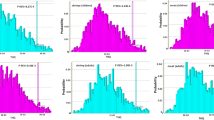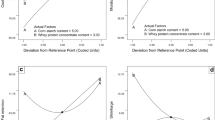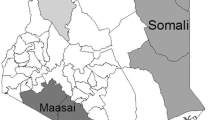Abstract
Acrylamide is a carcinogenic compound which is produced as a result of thermal processing of food materials such as French fries, cereals and meat products. In this study the effects of four different parameters on the level of produced acrylamide in two types of beef burgers during the frying was investigated. Each parameter was used in three levels (temperature at 170, 190, and 210 °C; frying time at 5, 6, and 7 min and meat level at 30, 60, and 85%, and also three types of oil, corn, canola and sunflower). Taguchi’s L9 design was applied to carry out the experiments. While temperature and meat level indicated more effect on the production of acrylamide in the studied samples, type of oil did not show any significant effects at all. Frying time (within the range studied here) showed minor contribution on the acrylamide level produced during the frying.






Similar content being viewed by others
References
Afoakwa EO, Quao J, Takrama J, Budu AS, Saalia FK (2011) Chemical composition and physical quality characteristics of Ghanaian cocoa beans as affected by pulp pre-conditioning and fermentation. J Food Sci Technol. doi:10.1007/s13197-011-0446-5
Ahn JS, Castte L, Clarke DB, Lioyd AS, Philo MR, Speck DR (2008) Verification of the findings of acrylamide in heated foods. Food Addit Contam 19:1116–1124
Alam MS, Amarjit S, Sawhney BK (2010) Response surface optimization of osmotic dehydration process for aonla slices. J Food Sci Technol 47:47–54
Chakraborty KS, Kumbhar BK, Chakraborty S, Yadav P (2010) Influence of processing parameters on textural characteristics and overall acceptability of millet enriched biscuits using response surface methodology. J Food Sci Technol 48:167–174
Fiselier K, Bazzocco D, Baumgartner FG, Grob K (2005) Influence of the frying temperature on acrylamide formation in French fries. Eur Food Res Technol 1:1–11
Gokmen V, Palazoglu TK, Senyuva HZ (2006) Relation between the acrylamide formation and time-temperature history of surface and core regions of French fries. J Food Eng 77:972–976
Gökmen V, Morales FJ, Ataç B, Serpen A, Lorenzo GA (2009) Multiple-stage extraction strategy for the determination of acrylamide in foods. J Food Comp Anal 22:142–147
Koh BK (2006) Determination of acrylamide content of food products in Korea. J Sci Food Agric 86:2587–2591
Luftig JT, Jordan VS (1998) Design of experiments in quality engineering. McGraw-Hill, New York
Mattus B, Hasse NU, Vosmann K (2004) Factors affecting the concentration of acrylamide during deep-fat frying of potatoes. Eur J Lipid Sci Tech 106:793–801
Mestdagh F, Meulenaer BD, Poucke CV, Detavernier C, Cromphout C, Peteghem CV (2005) Influence of oil type on the amounts of acrylamide generated in a model system and in french fries. J Agric Food Chem 53:6170–6174
Ölmez H, Tuncay F, Özcan N, Demirel S (2008) A survey of acrylamide levels in foods from the Turkish Market. J Food Comp Anal 21:564–568
Ooraikal B, Moledina KH (1981) Physicochemical changes in potato granules during storage. J Food Sci 46:110–116
Parzefall W (2008) Minireview on the toxicity of dietary acrylamide. Food Chem Toxicol 46:1360–1364
Pedreschi F, Kaack K, Granby K (2006) Acrylamide content and color development in fried potato Strips. Food Res Int 39:40–46
Pedreschi F, Kaack K, Granby K, Troncoso E (2007) Acrylamide reduction under different pre-treatments in French fries. J Food Eng 79:1287–1294
Petersson EV, Rosen J, Turner C, Danielsson R, Hellenas KE (2006) Critical factors and pitfalls affecting the extraction of acrylamide from foods: an optimization study. J Anal Chem 557:287–295
Pittet A, Perisset A, Oberson JM (2004) Trace level determination of acrylamide in cereal-based foods by gas chromatography-mass spectrometery. J Chromatogr A 1035:123–130
Rahmanian B, Pakizeh M, Mansoori SAA, Abedini R (2011) Application of experimental design approach and artificial neural network (ANN) for the determination of potential micellar-enhanced ultrafiltration process. J Hazard Mater 187:67–74
Serpen A, Gökmen V (2009) Evaluation of the Maillard reaction in potato crisps by acrylamide, antioxidant capacity and color. J Food Comp Anal 22:589–595
Shin DC, Kim CT, Lee YC, Choi WJ, Na YJ, Lee KW (2010) Reduction of acrylamide by taurine in aqueous and potato chip model systems. Food Res Int 43:1356–1360
Sogi DS, Sharma S, Oberoi DPS, Wani IA (2010) Effect of extraction parameters on curcumin yield from turmeric. J Food Sci Technol 47:300–304
Taguchi G (1986) Introduction to quality engineering. Asian Productivity Organization, Tokyo
Tan KK, Tang KZ (2001) Vehicle dispatching system based on Taguchi-tuned fuzzy rules. Eur J Oper Res 128:545–557
Tateo F, Bononi M, Andreoli G (2007) Acrylamide levels in cooked rice, tomato sauces and some fast food on the Italian market. J Food Comp Anal 20:232–235
Viklund G, Olsson KM, Sjöholm IM, Skog KI (2010) Acrylamide in crisps: effect of blanching studied on longterm stored potato clones. J Food Comp Anal 23:194–198
Weisshaar R (2004) Acrylamide in heated potato products—analytics and formation routes. Eur J Lipid Sci Technol 106:786–792
Yaylayan VA, Locas CP, Wnorowski A, O’brien J (2004) The role of creatine in the generation of n-methylacrylamide: a new toxicant in cooked meat. J Agric Food Chem 52:5559–5565
Yuan Y, Shu C, Zhou B, Qi X, Xiang J (2011) Impact of selected additives on acrylamide formation in asparagine/sugar Maillard model systems. Food Res Int 44:449–455
Author information
Authors and Affiliations
Corresponding authors
Rights and permissions
About this article
Cite this article
Ghasemian, S., Rezaei, K., Abedini, R. et al. Investigation of different parameters on acrylamide production in the fried beef burger using Taguchi experimental design. J Food Sci Technol 51, 440–448 (2014). https://doi.org/10.1007/s13197-011-0514-x
Revised:
Accepted:
Published:
Issue Date:
DOI: https://doi.org/10.1007/s13197-011-0514-x




